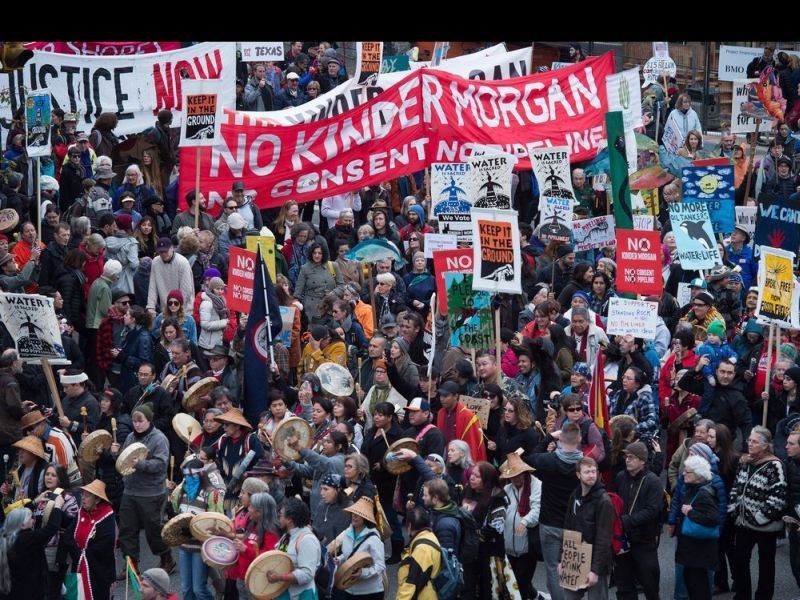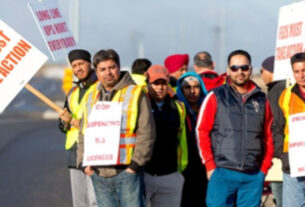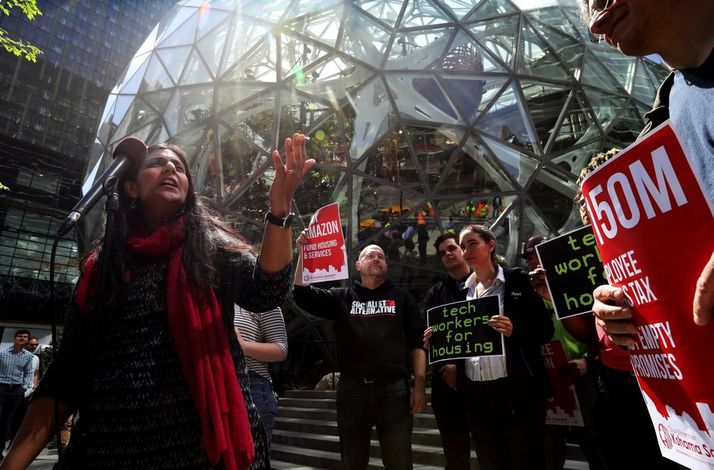Most of the world sees Canada’s Prime Minister, Justin Trudeau, as a progressive leader with a smiling face. He gained widespread support around the world for his promises at the Paris Climate Change conference to aim for 1.5o C temperature increase.
The reality is different, as he announced on November 29 the government’s approval of the construction of the Kinder Morgan pipeline from the Alberta tar sands to the port of Vancouver, British Columbia (BC). This pipeline, replacing a smaller existing one, will carry 890,000 barrels of diluted bitumen every day. The government also agreed to the expansion of Enbridge’s Line 3 pipeline from 390,000 to 915,000 barrels per day. This is a $7.5 billion, 1,660 kilometre pipeline from Alberta to Lake Superior in the US.
As part of the Paris Agreement, Canada pledged to reduce emissions 30 per cent below 2005 levels by 2030. Canada’s current policies are not expected to meet those targets; recent analysis by Climate Action Network stated that Canada will miss this target by 91 megatonnes by 2030. The two pipelines will increase Canada’s contribution by a further 27 megatonnes of CO2 every year (although burned elsewhere), equivalent to the pollution from 58 million cars on the road.
These actions fly in the face of not only the Paris commitments but the impressions he created during the 2015 federal election. The Liberal’s platform stated they would “provide national leadership … to take action on climate change” and “a renewed, nation-to-nation relationship with Indigenous Peoples, based on recognition, rights, respect, co-operation, and partnership” and “will respect [Indigenous People’s] legal traditions and perspectives on environmental stewardship.” Approving Kinder Morgan contradicts both of these.
Environmental Disaster
The pipeline’s purpose is to get the bitumen to a deep-water port for export, and therefore to burn it. This will increase global warming as it does not matter where the CO2 is released, the earth’s atmosphere and climate change are global and do not notice national boundaries.
Already the world is dangerously close to a tipping point on climate change. CO2 in the atmosphere is at record levels and 2016 set a new record for the hottest year. The arctic is destabilised with record warm temperatures and low ice levels. This will accelerate global warming as ice reflects the sun’s energy while open water absorbs energy. The permafrost of the north is melting, risking widespread releases of previously frozen methane which in the short-term is nearly 100 times as powerful a greenhouse gas as CO2.
The tar sands already is one of the worst environmental disasters on the planet. The mix of bitumen and soil is either surfaced-mined in huge pits or extracted by pumping steam into a well and pumping out the bitumen/sand/steam mix. The bitumen is separated from the sand using huge amounts of steam. The now contaminated water is stored in poisonous tailing ponds, covering 130 square kilometres. The process uses four times the energy of normal oil production and releases more CO2. The tar sands also release harmful air and water pollution that causes widespread damage to fish, animals and humans.
Once extracted the bitumen has to be diluted by natural gas condensate so that it will flow through the pipeline on its 1,150 kilometre route over mountains, across 700 rivers and through lands prone to landslides in a region at risk of earthquakes. Leaks and spills will happen; the current Kinder Morgan system has had four major spills in the Vancouver region since 2005. When the dilbit leaks the dilutant evaporates, it is highly flammable and contains benzene, a carcinogenic. The remaining bitumen is heavier than water and sinks in water so can be harder to remove.
The end of the pipeline is the port of Vancouver, home to over 2 million people. The new pipeline will result in over 400 Aframax tankers (245 metres long) a year travelling through the narrow port entrance past parks, beaches and people’s homes. The city relies for much of its income on tourism and its natural beauty. According the City of Vancouver, a spill in the harbour could threaten employment in a host of sectors, including real estate, tech, film, tourism and marine based industries that together employ more than 320,000 people in the region. This contrasts with the 50 permanent jobs that the project will provide in BC. The City estimates the economic costs of a spill could be $1.2 billion. The clean-up costs could be billions more, but Kinder Morgan will only pay up to $1.3 billion, so taxpayers would pay the rest.
Even if the bitumen is safely loaded onto a tanker and clears the harbour entrance, there are still risks of spills and collisions. The government claims it will bring in a world-class marine response system. This is highly unlikely and there is no safe response when a tanker carrying 750,000 barrels of bitumen has an accident. This is three times what the Exxon Valdez poured into the ocean and onto 2,000 kilometres of beaches of Alaska. That clean-up took years, but there is still spilled oil in the area, 27 years later. A spill in or around Vancouver would be a disaster.
Part of the Liberal Government’s Pattern
The Kinder Morgan announcement is not the only bad news for the planet from the federal Liberals. In the summer of 2016, they approved two BC proposals for the construction of the Site C dam and the Petronas plant to export Liquid Natural Gas.
Site C is a $9 billion plan to produce electricity that is not needed as BC’s usage is actually declining, but it will flood prime agricultural land on the Peace River that could feed one million people. The leader of BC’s First Nations, Grand Chief Stewart Philips, said that that giving the go-ahead is “an absolute betrayal.”
Petronas wants to build a huge plant to liquefy methane gas extracted by fracking. Fracking poisons huge volumes of water with hundreds of chemicals, many harmful to the health of humans and animals. It triggers earthquakes, with over 230 earthquakes in the fracking region of BC between August 2013 and October 2014. Methane leaks at every stage of the process. The entire LNG process would emit at least 12 million tonnes of carbon dioxide every year for 30 years which according to Environment and Climate Change Canada (a government body) would be “amongst the largest single point sources of greenhouse gas emission in the country.” The proposal at the mouth of the Skeena River could devastate BC’s second largest salmon run, which has an estimated annual value of $100 million and is vital to the Indigenous people of this region.
Attack on First Nations
The decision to approve the pipeline has outraged First Nations. An alliance of over 100 Nations have signed the Save the Fraser declaration opposing the pipeline. The Tsleil-Waututh Nation, whose traditional lands the pipeline terminal sits on, have vowed opposition. Instead of Trudeau’s promised “respect, co-operation, and partnership,” the federal government continues to ignore their views.
Pathetic Excuses
The Liberals claim while agreeing to the Kinder Morgan pipeline and other environmental bad news, they are acting to tackle climate change. They are looking at a modest tax on carbon and a partial phasing out of coal-fired power stations. This may reduce the CO2 released within Canada but building new pipelines will boost the global releases from Canadian sources. Their actions resemble an arsonist who sets a forest on fire and then uses a watering can to put it out.
Huge Opposition
There has been a growing campaign to oppose Kinder Morgan along with other proposed pipelines. When Kinder Morgan was surveying part of the route there were mass protests with 150 arrests for trespass. The charges were dropped because Kinder Morgan had incorrectly defined the no-go area. They are so incompetent they couldn’t get the right GPS coordinates, yet Trudeau trusts them to build a pipeline.
Major city councils in Metro Vancouver are in total opposition to the pipeline. The Mayor of Burnaby, where the pipeline will end, has pledged that he will stand in front of the bulldozers.
A few weeks before the announcement there was the largest demonstration in years in Vancouver with thousands marching to make clear their determination to resist. Already, nearly 20,000 people have pledged to take direct action to stop Kinder Morgan. There will be Standing Rocks on the pipeline’s route.
Understanding the Liberals’ Actions
To develop a strategy to defeat the pipeline we need clarity on why the Liberals decided to go ahead. Trudeau can be in no doubt about the strong opposition and the political risks for the Liberals.
It destroys their image as environmentalists willing to act on climate change. It will severely damage the Liberals attempts to win support from First Nations. The third largest city in Canada is opposed. The image of the Royal Canadian Mounted Police attacking Indigenous protection camps, such as seen in North Dakota, would be a publicity nightmare. Incredibly the Natural Resources Minister, Jim Carr, threatened to use the military against anti-pipeline actions deemed “not to be peaceful.” There are 15 Liberal MPs, including three members of the Cabinet, in the metropolitan Vancouver area.
Clearly the Liberals think these risks are worth it. Why? In spite of all their words, they are committed to the fossil fuel economy in the hope that the export of bitumen will provide revenue to the government and provide jobs. The alternative pipeline, Energy East, has even greater political risks as it goes through central Ontario and Québec including the city of Montréal, with far more Liberal MPs including Trudeau himself, at risk of being defeated.
The pipeline has support in Alberta, including from the NDP government, as they believe it will provide jobs in a province hit by the sharp fall in oil prices. Winning support in Alberta and from the NDP will help the Liberals plan to permanently weaken the NDP. They also hope to undermine support for the Conservatives, whose base is in Alberta. The Liberals expect to gain support from some unions who see major construction projects as providing jobs. Yet there will only be 40 jobs in Alberta and 50 in BC once the pipeline is built.
A Program for Victory
Clearly the stakes are high – the Liberals have decided on a high risk strategy. A program for victory needs to make the costs so high they cannot go ahead.
The BC Liberal government has sat on the fence hoping for more revenue. It is likely that they will get some concessions and give the green light. The BC NDP must commit to blocking the pipeline with all the tools available to the provincial government and go all-out to win the election in May 2017.
It is certain that First Nations, and cities in the area will launch court challenges rightly pointing to the deeply flawed National Energy Board’s Review Panel, appointed by the previous Conservative Prime Minister Harper, that gave the OK to the pipeline. However this cannot be the main or only strategy – it is best used to provide time to build a strong campaign. There are plans for mass blockades and civil disobedience along with a campaign to win widespread public support. All of these the Liberals will have included in their calculations. The campaign to win should raise the stakes.
A program of good secure jobs would seriously undermine support for the pipeline in parts of BC. An NDP commitment to seriously invest in renewable energy, insulating buildings and public transit would provide far more jobs than building a pipeline These good jobs would be funded by taking the resources of Kinder Morgan into the public ownership and re-directing the money for the Site C dam (at least $9 billion). Such a program in BC would help win union and public support for the alternative to the pipeline. It would open a real debate in the Alberta unions and NDP about an alternative to the dependency on the tar sands, with all their negative social and environmental impacts.
If court cases, demonstrations and blockades are not enough to force the Liberals to back down, a conference of all groups and organizations opposed to Kinder Morgan could be called to discuss the next steps. One of the actions that Socialist Alternative would argue for would be a one-day shutdown of the Vancouver area involving the port, transport, workplaces, schools and universities. Everyone who lives and works in Vancouver has a stake in stopping Kinder Morgan. Such an action would hit the Liberal’s backers hard – in their profits.




